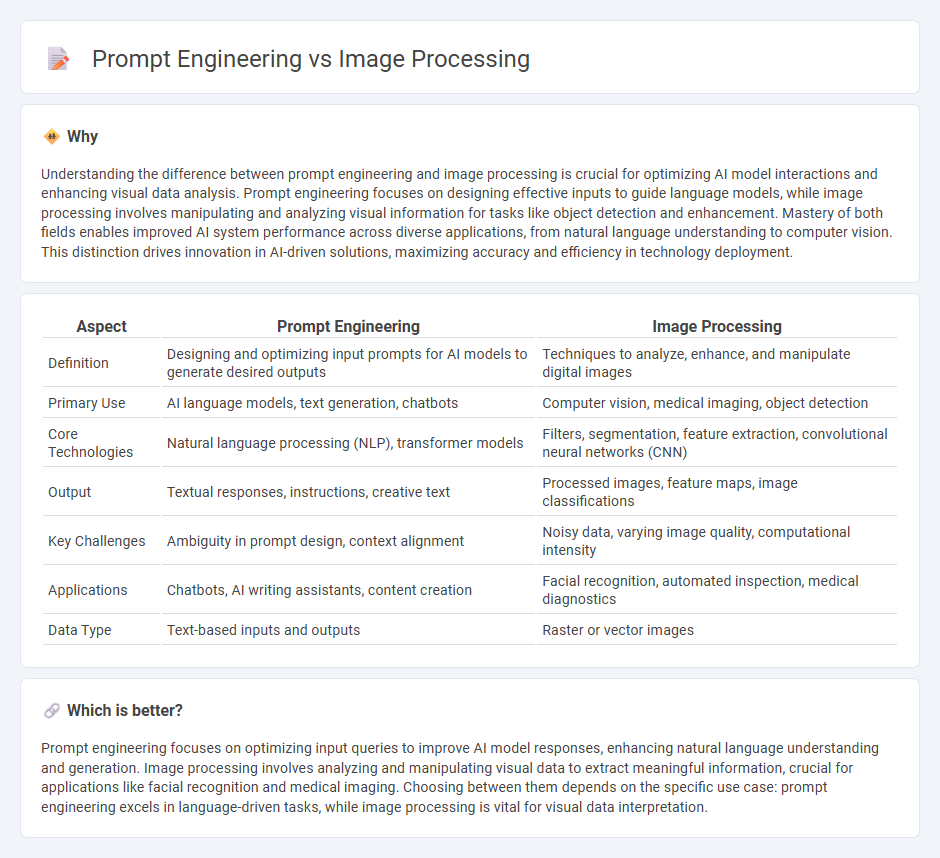
Prompt engineering harnesses natural language processing models to generate tailored text outputs based on user input patterns, optimizing AI-driven communication. Image processing involves analyzing and manipulating digital images to extract meaningful information, enhancing applications in computer vision and machine learning. Discover how these cutting-edge technologies transform data into powerful insights.
Why it is important
Understanding the difference between prompt engineering and image processing is crucial for optimizing AI model interactions and enhancing visual data analysis. Prompt engineering focuses on designing effective inputs to guide language models, while image processing involves manipulating and analyzing visual information for tasks like object detection and enhancement. Mastery of both fields enables improved AI system performance across diverse applications, from natural language understanding to computer vision. This distinction drives innovation in AI-driven solutions, maximizing accuracy and efficiency in technology deployment.
Comparison Table
| Aspect | Prompt Engineering | Image Processing |
|---|---|---|
| Definition | Designing and optimizing input prompts for AI models to generate desired outputs | Techniques to analyze, enhance, and manipulate digital images |
| Primary Use | AI language models, text generation, chatbots | Computer vision, medical imaging, object detection |
| Core Technologies | Natural language processing (NLP), transformer models | Filters, segmentation, feature extraction, convolutional neural networks (CNN) |
| Output | Textual responses, instructions, creative text | Processed images, feature maps, image classifications |
| Key Challenges | Ambiguity in prompt design, context alignment | Noisy data, varying image quality, computational intensity |
| Applications | Chatbots, AI writing assistants, content creation | Facial recognition, automated inspection, medical diagnostics |
| Data Type | Text-based inputs and outputs | Raster or vector images |
Which is better?
Prompt engineering focuses on optimizing input queries to improve AI model responses, enhancing natural language understanding and generation. Image processing involves analyzing and manipulating visual data to extract meaningful information, crucial for applications like facial recognition and medical imaging. Choosing between them depends on the specific use case: prompt engineering excels in language-driven tasks, while image processing is vital for visual data interpretation.
Connection
Prompt engineering and image processing are interconnected through the development of advanced AI models that interpret and generate visual content based on textual inputs. By optimizing prompt designs, AI systems enhance image recognition, classification, and generation accuracy in applications such as computer vision and augmented reality. The synergy between prompt engineering and image processing drives innovation in deep learning frameworks, enabling more precise multimodal data analysis and improved human-computer interaction.
Key Terms
**Image Processing:**
Image processing involves the manipulation and analysis of digital images through algorithms to enhance visual quality, extract meaningful information, or enable computer vision applications such as object detection and image segmentation. Techniques include filtering, edge detection, and pattern recognition, which are essential in fields like medical imaging, autonomous vehicles, and surveillance systems. Explore detailed methodologies and practical applications of image processing to deepen your understanding.
Convolutional Neural Networks (CNNs)
Convolutional Neural Networks (CNNs) revolutionize image processing by automatically extracting hierarchical features from visual data, enabling applications such as object recognition, segmentation, and image classification. In prompt engineering, CNNs are less central, as it centers on optimizing textual input for language models rather than direct pixel-level analysis. Explore the distinct roles of CNNs in image processing and their limited application in prompt engineering to deepen your understanding.
Pixel Manipulation
Pixel manipulation in image processing involves direct alteration of pixel values to enhance, restore, or analyze images using techniques such as filtering, transformation, and noise reduction. Prompt engineering in AI focuses on crafting precise text inputs to guide generative models in producing relevant visual content, relying on semantic understanding rather than pixel-level changes. Explore the differences in methodologies and applications between pixel manipulation and prompt engineering to deepen your knowledge.
Source and External Links
Digital Image Processing Basics - GeeksforGeeks - Digital image processing uses algorithms and mathematical models for improving image quality, extracting information, and automating tasks through steps like acquisition, enhancement, restoration, segmentation, analysis, and compression.
What Is Image Processing: Overview, Applications, Benefits, and More - Image processing involves transforming images into digital form, performing operations such as enhancement, restoration, color processing, segmentation, and recognition to extract useful information.
Image Processing: Techniques, Types, & Applications [2024] - V7 Labs - Image processing techniques include enhancement, restoration, color processing, wavelets, compression, and morphological processing to manipulate and analyze digital images effectively.
 dowidth.com
dowidth.com